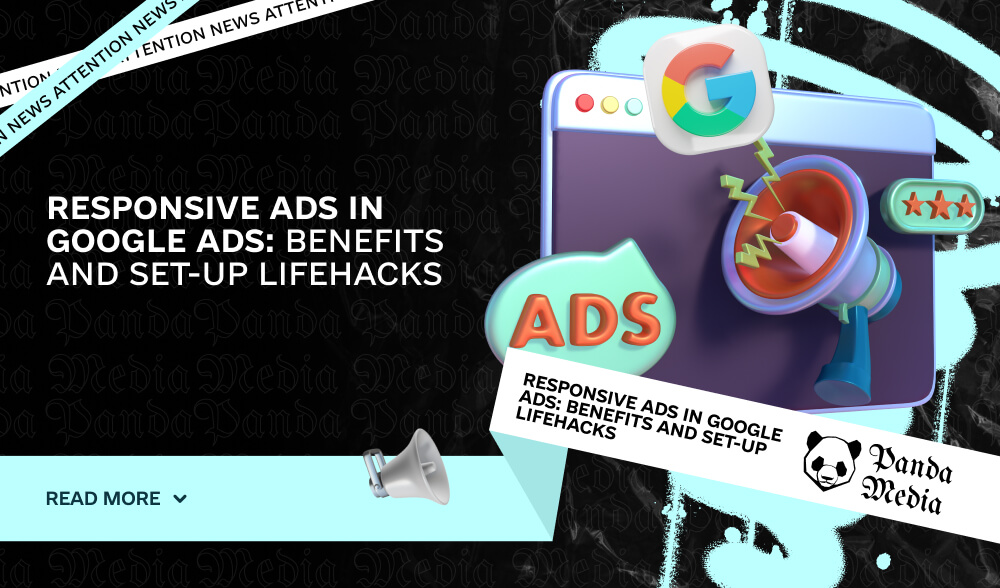Manual testing is time-consuming and time-consuming. However, Google Ads provides a tool that automates this process and saves many hours of work. We are talking about adaptive ads, which also increase the number of impressions.
In this article, we will take a closer look at what responsive ads are, how to maximize their potential, and how to improve the efficiency of working with this type of advertising creative.
Adaptive ads: what are they and what are their features
Adaptive ads on Google have an advertising format that includes automatic testing of creatives. To get quick results, you need to prepare various images and texts, then upload them to the system. Google Ads algorithms and tools will automatically perform testing to determine the most effective combinations of elements.
Element restrictions: you can upload up to 15 titles and up to 4 descriptions.
Google Ads artificial intelligence combines the proposed titles and descriptions by analyzing audience behavior and other parameters. As a result, different users can see unique combinations of titles and descriptions.
Google offers two main types of adaptive advertising:
- Midstream ads. Google adapts such ads to specific sites by adjusting the format and size. These ads are displayed in the Google contextual advertising network.
- Search ads. They become visible to users when they search on Google. The AI algorithm selects texts and descriptions based on the target audience.
Adaptive ads can be used to promote various campaigns, except for YouTube videos and Google Shopping cards.
Working with responsive ads
Creating responsive ads involves a few simple steps:
- Sign in to your Google Ads account and select the Search Network Campaigns section. Then go to the Ads & Extensions tab.
- To create ads, use the “Adaptive Ads” section, focusing on the type of advertising – either Display or Search.

- Customize your impressions by specifying your ad target groups, adding titles, descriptions, and images.
- Launch your ads following Google’s recommendations that will help you with the setup process. An important aspect is the “Ad Quality”, which must be closely monitored to ensure that it remains within the normal range.
Adaptive ads can be edited and customized. To do this, follow these steps:
- Go to Google Ads and select the Ads & Extensions tab.
- Filter your ad campaigns by clicking above the table and selecting the desired ad type.
- Find an ad that needs changes, hover over it, and make the adjustments.
- After making changes, be sure to click the “Save” button. You’re done!
What are the benefits of responsive ads?
Let’s take a look at why using responsive ads is a profitable solution:
- Artificial intelligence. Google is implementing machine learning algorithms that analyze large amounts of data. The system monitors user behavior and their response to advertising, automatically adjusting ads to the target audience.
- Frequency of impressions. Adaptive ads from Google are displayed with increased frequency and for various requests, which increases their visibility.
- Automatic optimization. For arbitrageurs, there is no need to manually adjust the size of creatives when it comes to display advertising. All advertising materials are adapted to the placement automatically.
- Increase efficiency. Adaptive ads allow you to reduce the time spent on routine tasks. You just need to create catchy headlines and interesting descriptions – the rest of the work will be done by the Google algorithm.
Recommendations and life hacks
We have analyzed and collected several recommendations that will help improve the use of adaptive ads:
- Use the recommendations. Google provides hints and tips when setting up ad campaigns. Be sure to familiarize yourself with them, adapt them to your offer, and put them into practice to achieve the best results.
- Combine headlines. You can combine headlines and descriptions. For example, if a headline is suitable for only one description, it may be inappropriate for others.

- Don’t rush into changes. Algorithms need time to learn to achieve optimal results. They analyze the target audience, user behavior, and reactions to ads. If initially the effectiveness of the ad is low, do not rush to delete it – it may be worth giving it a chance.
- Follow Google’s advertising policy. Moderation is still relevant – your creatives should not contain prohibited elements. Do not allow misleading, deceptive, animated ads and text exceeding more than 20% of the image area.
What to consider when working with texts:
- Length. The title should fit in 30 characters, and the description – in 90 characters.
- Keywords. It is recommended to research the most popular keys and implement them in the titles to increase visibility and clicks.
- Variety of text lengths. When creating content, you should prepare several versions – both short and long. Different audience groups may prefer texts of different lengths.
- Personalization. The audience should be segmented and the “pains” of each group should be taken into account. For example, you should use different messages for people of different ages, genders, and social status: one text for young people, another – for the elderly.
- Trust. It is important to gain the trust of users by demonstrating how the product helps solve their problems. It is useful to mention the guarantees and reliability of the offer, as well as to have documents and certificates that platforms such as Google may request.
Conclusion
Responsive ads are a modern solution from Google that can significantly reduce testing time and increase conversion rates. Apply the recommendations from our guide to take your Google campaigns to new heights!


